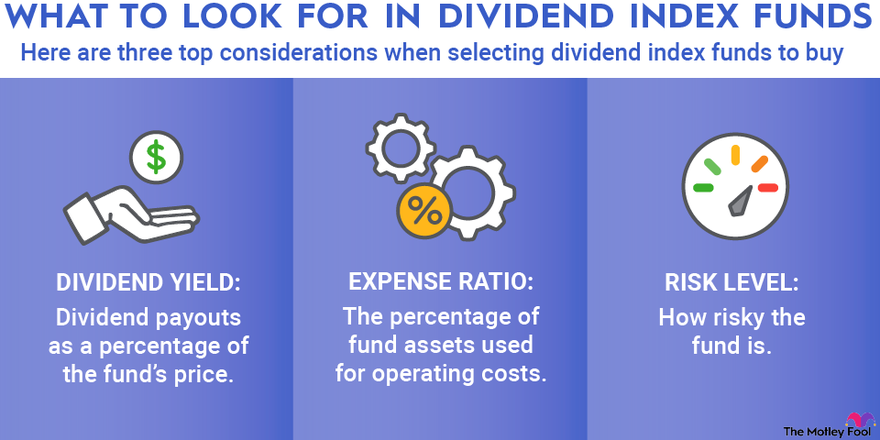What are dividend index funds? Let’s take each word in reverse order.
First, they’re funds — either mutual funds or exchange-traded funds (ETFs). Second, they attempt to track an index comprising multiple stocks. Third, they focus on stocks that pay dividends.

Image source: The Motley Fool.
Just as dividend stocks aren’t ideally suited for every investor, dividend index funds won’t appeal to everyone.
However, if you’re primarily interested in obtaining steady income rather than high growth from your investments, these funds could be just what you’re looking for — and there’s no stock-picking required.
Top dividend index funds
Eight top dividend index funds to buy
Here are eight dividend index funds (in no particular order) that have relatively low expense ratios but varying dividend yields and risk levels.
| Fund | Dividend Yield | Expense Ratio | Risk Level |
|---|---|---|---|
| Invesco S&P 500 High Dividend Low Volatility ETF (NYSEMKT:SPHD) | 4.12% | 0.30% | Below average |
| iShares Core High Dividend ETF (NYSEMKT:HDV) | 3.51% | 0.08% | Average |
| ProShares S&P 500 Dividend Aristocrats ETF (NYSEMKT:NOBL) | 2.32% | 0.35% | Average |
| Schwab U.S. Dividend Equity ETF (NYSEMKT:SCHD) | 3.39% | 0.06% | Average |
| Vanguard High Dividend Yield ETF (NYSEMKT:VYM) | 3.00% | 0.06% | Average |
| Vanguard Dividend Appreciation ETF (NYSEMKT:VIG) | 1.76% | 0.06% | Average |
| iShares Core Dividend Growth ETF (NYSEMKT:DGRO) | 2.36% | 0.08% | Average |
| WisdomTree U.S. Quality Dividend Growth Fund (NASDAQ:DGRW) | 2.71% | 0.28% | Average |
1. Invesco S&P 500 High Dividend Low Volatility ETF (SPHD)
This ETF tracks the S&P 500 Low Volatility High Dividend Index. It isolates the highest-yielding stocks in the index and then selects the 50 lowest-volatility ones. One thing to note with SPHD is that it pays monthly dividends.
2. iShares Core High Dividend ETF (HDV)
This ETF is benchmarked to the Morningstar Dividend Yield Focus Index. It holds 75 U.S. high-yielding dividend stocks with overweights in the energy, consumer staples, and healthcare sectors.
3. ProShares S&P 500 Dividend Aristocrats ETF (NOBL)
This ETF tracks the performance of Dividend Aristocrats® — S&P 500 members that have increased their dividends for at least 25 consecutive years. (The term Dividend Aristocrats® is a registered trademark of Standard & Poor’s Financial Services LLC.) The focus here is not on high yields but rather companies that have consistently grown dividends. The index is equal-weighted.
4. Schwab U.S. Dividend Equity ETF (SCHD)
This ETF seeks to track the total return of the Dow Jones U.S. Dividend 100 index. This index uses a composite score that screens for a minimum of 10 years of dividend payments, free cash flow to total debt, return on equity, dividend yield, and a five-year dividend growth rate.
5. Vanguard High Dividend Yield ETF (VYM)
This ETF tracks the performance of the FTSE High Dividend Yield Index, which selects the 55% highest-yielding stocks from a broader universe of U.S. equities. However, it excludes real estate investment trusts (REITs).
6. Vanguard Dividend Appreciation ETF (VIG)
The opposite of VYM, this ETF tracks the S&P U.S. Dividend Growers Index. It screens potential holdings for at least 10 consecutive years of dividend growth in addition to omitting the top 25% highest-yielding stocks to ensure quality.
7. iShares Core Dividend Growth ETF (DGRO)
This ETF also targets dividend growth stocks via the Morningstar US Dividend Growth Index. By doing so, DGRO requires five consecutive years of dividend growth and a positive consensus earnings forecast and payout ratio of less than 75%. It also omits the top 10% highest-yielding stocks.
8. WisdomTree U.S. Quality Dividend Growth Fund (DGRW)
This ETF tracks the proprietary WisdomTree U.S. Quality Dividend Growth Index, which screens holdings based on three-year historical averages for return on equity (ROE) and return on assets (ROA), long-term earnings growth expectations, and weights the portfolio by yield.
What to look for
What to look for in dividend index funds
A good first step is to determine your overall asset allocation and, as a follow-up, the amount of money you have to invest in stocks and/or equity index funds.
Once you’ve done the pre-work, you can visit any of the major online discount brokerages, such as Vanguard, Fidelity, or Charles Schwab, all of which offer free (or very low-cost) ETF trading.
Here are three top considerations when selecting dividend index funds to buy:
- Dividend yield: Dividend payouts as a percentage of the fund’s price.
- Expense ratio: The percentage of fund assets used for operating costs.
- Risk level: The riskiness of the fund.
To some extent, there’s a trade-off between dividend yield and risk level. Generally speaking, higher yields are associated with higher risk, but higher expense ratios don’t necessarily translate to higher dividend yields or lower risk levels.
It’s also important to remember that dividend yield alone does not act as a perfect indicator of future performance.
Focusing only on companies paying dividends leaves out many that derive their growth from price appreciation, such as those in big tech.
Make sure you construct a diversified portfolio that covers a wide population of underlying firms with different capital strategies.
Long-term investments
Dividend index funds are long-term investments
The stock market can be volatile in the short term. So, it’s important to keep in mind that dividend index funds are meant to be held for the long run.
First, the longer you hold your index funds, the better performance you’re likely to see. Longer holding periods lend themselves to more compounding, which enables your money to grow rapidly in later years.
Second, short-term market movements tend to be unreliable when it comes to successful investing. As we’ve seen this year, short-term market swings can be erratic both in direction and magnitude.
However, longer-term investment horizons have reliably trended upward, especially when it comes to dividend-paying blue chip stocks.
Finally, longer holding periods also make your portfolio more tax-efficient. If you keep your dividend index funds for longer than a designated holding period, you’ll be eligible for qualified dividends, which are taxed at a lower capital gains rate when earned.
If you do choose to allocate a portion of your portfolio to dividend index funds, know that short-term price movements are entirely normal. A long-term focus has historically been a preferable strategy.
Related index fund topics
Why invest?
Why invest in dividend index funds?
Dividend index funds will be most attractive to income-seeking investors.
The top funds provide solid dividend yields and diversification across a wide range of stocks, which can be less risky than buying a smaller number of individual dividend stocks.
In addition, high-yielding dividend index funds can be a great way to identify a portfolio of value stocks, while dividend growth index funds can be a way of identifying quality stocks.
View dividend index funds as part of a broadly diversified portfolio that considers your overall risk tolerance and return expectations.
FAQ
FAQ
Are there dividend-paying index funds?
Yes, there are several dividend-paying index funds for investors who prioritize steady income over high growth.
Do Vanguard index funds pay dividends?
A number of well-regarded Vanguard index funds pay dividends, including the Vanguard High Dividend Yield ETF (VYM) and the Vanguard Dividend Appreciation ETF (VIG)
Are dividend index funds risky?
The level of risk associated with a dividend index fund depends on its holdings. It’s crucial to check the holdings of any dividend index fund that you’re considering to assess the risk of an investment.
Which dividend fund is best?
The best dividend funds depend on your risk tolerance. A great all-round candidate is the Schwab U.S. Dividend Equity ETF (SCHD) with a low 0.06% expense ratio, decent 3.39% yield, and stringent index criteria.
Does an S&P 500 index fund pay dividends?
Yes, most S&P 500 index funds will pay dividends, but they will not be as high as those from dividend index funds.
Do ETF index funds pay dividends?
Most index funds structured as ETFs will pay dividends, although the amount and frequency can vary greatly.





